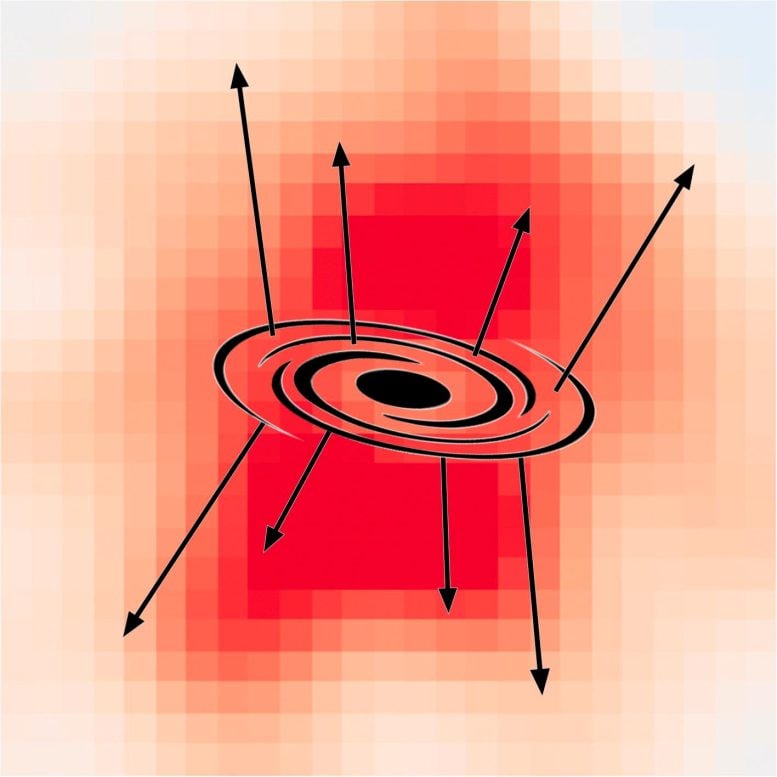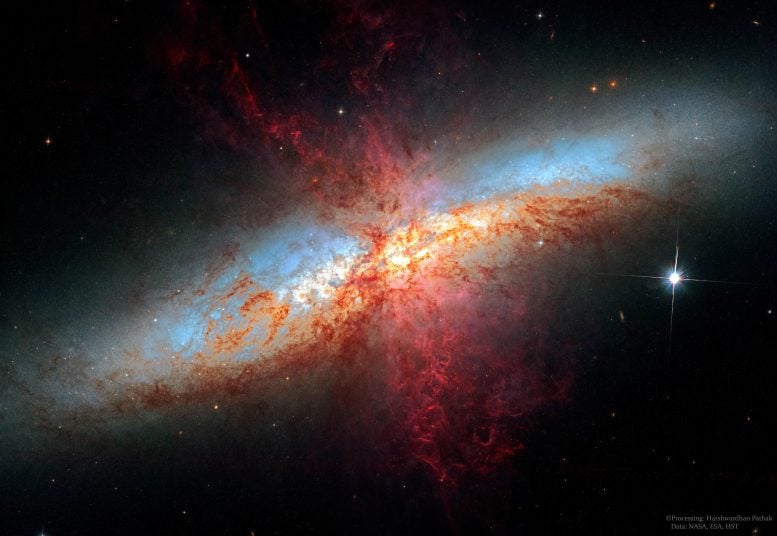

The MUSE instrument has revealed that “galactic winds” — massive matter outflows from galaxies — are a frequent phenomenon. This discovery, made by observing around 100 galaxies, provides significant insights into the role of these outflows in galaxy evolution and confirms theoretical models. Credit: SciTechDaily.com
Recent research using the MUSE instrument shows that galactic winds, vital for galaxy evolution, are a common occurrence in the universe, challenging previous assumptions about their rarity.
Under certain circumstances galaxies release huge quantities of matter into their environment, triggered by a large number of explosions of massive stars. The MUSE instrument of the Very Large Telescope of the European Southern Observatory (ESO) has now demonstrated for the first time that such “galactic winds” are by no means rare, but actually occur frequently.
Discovery of Double-Cone Structures
An international research team, led by the Centre national de la recherche scientifique (CNRS), found the double-cone-shaped structures characteristic of galactic winds when examining a sample of around 100 galaxies. However, these are only visible in specific spectral lines of light and only if the sensitivity of the measurement is extremely high. Previously only very few such cases were known, most of which were discovered also with the MUSE instrument.

Theoretical sketch for galactic winds. The distribution in the background (red) shows the gas outflows of galaxies detected by MUSE. Credit: Guo et al. 2023, AIP.
Professor Lutz Wisotzki, head of the Galaxies and Quasars section at the Leibniz Institute for Astrophysics Potsdam (AIP) and co-author of the article in the science journal Nature says: “MUSE shows us that such galactic-wide outflows are present in almost every star-forming galaxy. In addition, the new results allow us to recognize exactly what size and shape these galactic winds typically have. Until now, this was only possible in very rare extreme cases.”
Role of Outflowing Gas in Cosmic Evolution
Outflowing gas is thought to play a crucial role in the cosmic evolution of galaxies by regulating their growth and star formation. Theoretical calculations predict “bipolar” shapes for the outflows, which extend above and below the galactic plane far into the circumgalactic medium. Similar shapes have also been observed directly in some nearby galaxies, such as the “cigar galaxy” M82 and even in our own Milky Way, but there we can only see the innermost regions and cannot create an overall picture.

Galactic winds are observed in nearby galaxies, such as M82, which is called “Cigar Galaxy” because of its shape. Credit: NASA, ESA, Hubble; Processing & Copyright: Harshwardhan Pathak
Galactic Winds in the Young Universe
Cosmological simulations of galaxy formation predict for the young universe that the phenomenon of galactic winds occurred much more frequently and strongly during these early phases: Due to the higher star formation activity of young galaxies, there were more supernova explosions and thus stronger outflows. These transport gas and energy from a galaxy into its surroundings, thus depriving it of the necessary fuel for further star formation, while at the same time enriching its “circumgalactic” environment. This so-called feedback process is presumably a crucial element in our understanding of the formation and evolution of galaxies, but it has only been insufficiently constrained through observations due to the difficulty of detecting the phenomenon.
New Insights From MUSE
The new study with the MUSE instrument now shows directly that the galactic gas flows out into the surroundings of the galaxies, reaching distances of more than 30,000 light years. The observable signal depends strongly on the orientation of the galaxy relative to the line of sight: if the system is viewed from the side, there is strong emission above and below the plane of the galaxy, whereas for galaxies viewed from “above” or “below,” the signal is weaker and more evenly distributed. These observations impressively confirm the previously theoretically predicted bipolar form of the outflows perpendicular to the plane of the galaxy.
Reference: “Bipolar outflows out to 10 kpc for massive galaxies at redshift z ≈ 1” by Yucheng Guo, Roland Bacon, Nicolas F. Bouché, Lutz Wisotzki, Joop Schaye, Jérémy Blaizot, Anne Verhamme, Sebastiano Cantalupo, Leindert A. Boogaard, Jarle Brinchmann, Maxime Cherrey, Haruka Kusakabe, Ivanna Langan, Floriane Leclercq, Jorryt Matthee, Léo Michel-Dansac, Ilane Schroetter and Martin Wendt, 6 December 2023, Nature.
DOI: 10.1038/s41586-023-06718-w

